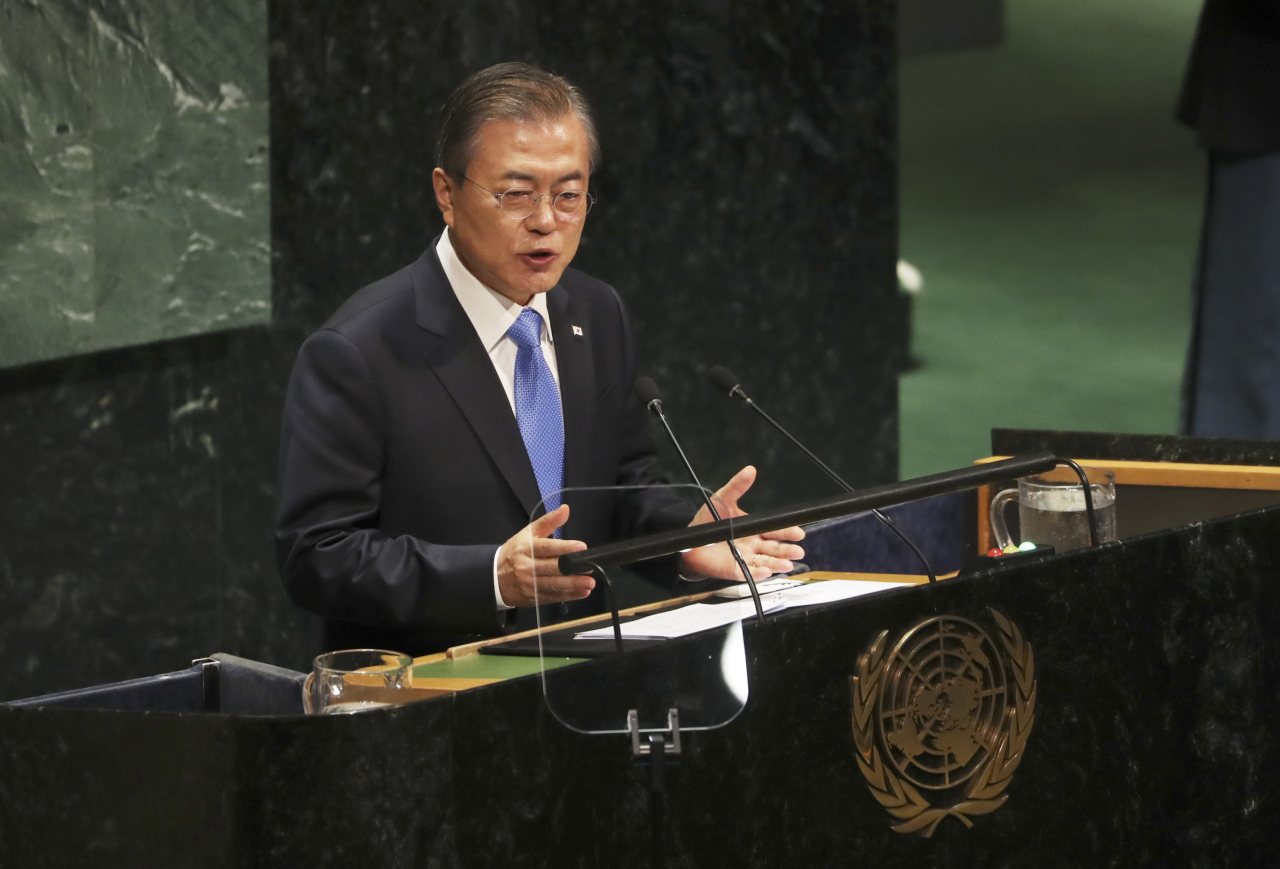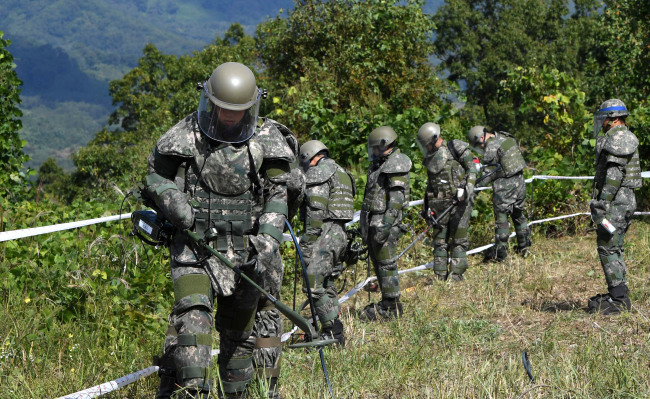[Feature] Tall order to transform DMZ minefields into peace zone
More than 1 million land mines believed to be in DMZ
By Jo He-rimPublished : Oct. 28, 2019 - 16:51
After a short-lived period of detente for the two Koreas, the North appears to be back to cold-shouldering the South. But this has not deterred the Moon administration from drawing up plans for lasting peace on the Korean Peninsula.
As part of its effort to achieve that goal, Moon proposed to transform the Demilitarized Zone that separates the two Koreas into an “international peace zone” at a UN session last month.
But the DMZ that the president called the “ecological treasure trove” of wildlife, remains a site of military tension, with more than a million land mines believed to be planted in the area.
Acknowledging the huge presence of land mines, Moon addressed the need to clear them and called for support from the international community.
As part of its effort to achieve that goal, Moon proposed to transform the Demilitarized Zone that separates the two Koreas into an “international peace zone” at a UN session last month.
But the DMZ that the president called the “ecological treasure trove” of wildlife, remains a site of military tension, with more than a million land mines believed to be planted in the area.
Acknowledging the huge presence of land mines, Moon addressed the need to clear them and called for support from the international community.

“Approximately 380,000 anti-personnel mines are laid in the DMZ, and it is expected to take 15 years for South Korean troops to remove them on their own,” Moon said in his keynote speech in the 74th session of the UN General Assembly in New York last month.
DMZ, a minefield
For the 250-kilometer-long, 4-km-wide DMZ to be turned into the proposed place for co-prosperity of the two Koreas, and the international center of peace operations and arms control, eliminating all the mines in the region is one of the first steps to take.
While Moon specified the number of anti-personnel mines to be 380,000, the exact figure for all the different types of mines planted north and south of the Military Demarcation Line has not been confirmed.
Mine experts believe about 1 million to 1.2 million mines have been planted by the South Korean and US militaries, on the southern side of the DMZ. Adding the number of mines buried by the North, the total number of mines could be as large as 2 million.
The anti-personnel and anti-tank mines in the DMZ are not all direct remnants of the Korean War.
According to Korea’s International Campaign to Ban Landmines, an international anti-mine organization, the tens of thousands of land mines were planted in the DMZ from around 1962, as global tensions heightened with the Cuban Missile Crisis.
At the time, both Koreas and the US planted anti-personnel mines, such as M4, M14 and M16 mines, violating the armistice.
While land mines may be appear frequently in war novels, their use is largely taboo. The two Koreas are on the list of about 30 countries around the world that have not joined the Ottawa Convention, an agreement to eliminate the usage of anti-personnel land mines.
The 164 countries that joined the convention are banned from producing and developing land mines.
All signatories are required to destroy the stockpiles of anti-personnel mines within four years, and all land should be cleared of the mines within 10 years after ratifying the treaty -- a challenge that the two Koreas have not undertaken.
South Korea, however, has demonstrated its intention to eliminate the mines. When the relationship with the North thawed in 2000, following the first inter-Korean summit between President Kim Dae-jung and North Korean leader Kim Jong-il, Seoul joined the Convention on Certain Conventional Weapons.
The treaty, which aims to reduce the usage of “inhumane weapons,” bans the usage of anti-personnel land mines that cannot be detected by common mine detection equipment. This means that the mines should carry more than 8 grams of iron, so they can be detected, Kim Ki-ho, the head of Korea Mine Clearance Research Institute, told The Korea Herald.
“But South Korea is already violating the CCW, with the M14 anti-personnel mines already planted in the DMZ,” Kim explained. “When the country joined the CCW, they had a grace period of nine years to remove the M14, but it has not happened.”
Clearing DMZ of mines
While it is not impossible to remove all land mines in the DMZ, experts believe it would take years.
“(Moon’s) proposal has just suggested the idea, and it would take a long time for detailed operation plans to be drawn up,” a military official said, adding that they have not yet started on the demining plan.
“While the president said it would take about 15 years for the South Korean military to clear out the 380,000 anti-personnel mines, it can take much longer considering that it got rid of just 240 mines in 2018,” Cho Jae-guk, the chief of the Korean branch of the International Campaign to Ban Landmines, told The Korea Herald.

“The Defense Ministry here had said it would take about 489 years to remove all land mines inside Korea.”
To start demining, the South Korean government must get approval from the US-led United Nations Command, which overlooks all activities inside the DMZ.
UNC was established in 1950 to defend South Korea against North Korea when the Korean War broke out. As the enforcer of the 1953 Armistice Agreement, the UNC has since held jurisdiction over the DMZ.
For professionals from international and civic organizations to participate in removing the anti-personnel mines, the current military law would also have to be revised or a new one draw up.
The Protection of Military Bases and Installation Act in Korea stipulates that all military operations can only be undertaken by the military, meaning that civilian experts cannot participate in the demining operations.
Changing the law and allowing civilian experts to take part in the demining operation would be much faster and cost-effective than relying exclusively on conscripted soldiers, Kim Ki-ho, the mines expert said.
Lack of proper management of the mines that were planted so long ago would slow down the demining process, according to military officials.
“The DMZ has been closed off for decades. Even those mines that are mapped may have been carried away in rain, wind or landslide,” an official explained.
Experts also point out that it is important for the demining operation to be careful to not damage the wildlife that has been thriving there for decades, untouched by humans.
The biggest hurdle, however, is the unstable relationship with North Korea. If the South Korean government conducts unilateral demining operations, it would only be half of the plan, as it would not be able to clear out the mines north of the military demarcation line inside the DMZ.
“There is no reason to keep the mines anymore and we need to get rid of them as soon as we can,” Cho from ICBL said. “Peace would be actualized when the military and international organizations cooperate to demine the DMZ and turn the area into a peace zone.”
By Jo He-rim (herim@heraldcorp.com)








![[Graphic News] More Koreans say they plan long-distance trips this year](http://res.heraldm.com/phpwas/restmb_idxmake.php?idx=644&simg=/content/image/2024/04/17/20240417050828_0.gif&u=)
![[KH Explains] Hyundai's full hybrid edge to pay off amid slow transition to pure EVs](http://res.heraldm.com/phpwas/restmb_idxmake.php?idx=644&simg=/content/image/2024/04/18/20240418050645_0.jpg&u=20240419100350)







![[KH Explains] Hyundai's full hybrid edge to pay off amid slow transition to pure EVs](http://res.heraldm.com/phpwas/restmb_idxmake.php?idx=652&simg=/content/image/2024/04/18/20240418050645_0.jpg&u=20240419100350)

